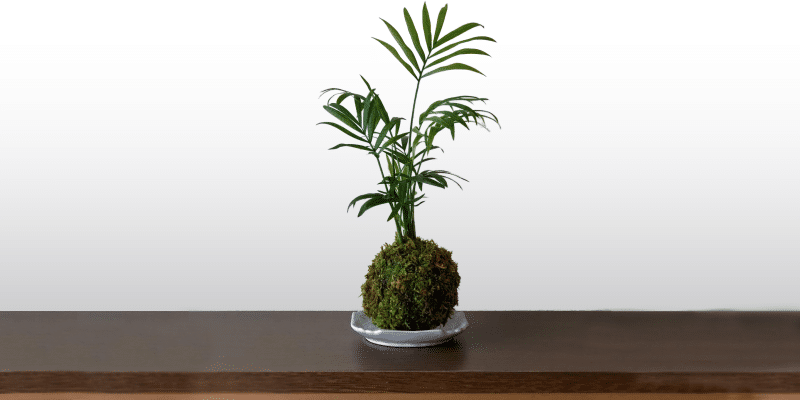Parlor Palm is one of the easiest houseplants to take care of, full stop. Grown indoors since Victorian times, it’s a smaller tree that’s great at adapting to lower light environments.
Widely available and super affordable, Parlor Palm offers a collection of green fronds that will instantly liven up any living room or office — without taking up too much space.
Maybe best of all, this stunner doesn’t only look great, it also doubles as an air-purifying powerhouse!
Let’s find out where the Parlor Palm came from, why people love it so much, and how to give it the care it needs to stay happy.
Table of Contents
Parlor Palm Care Guide
History, habitat, and characteristics
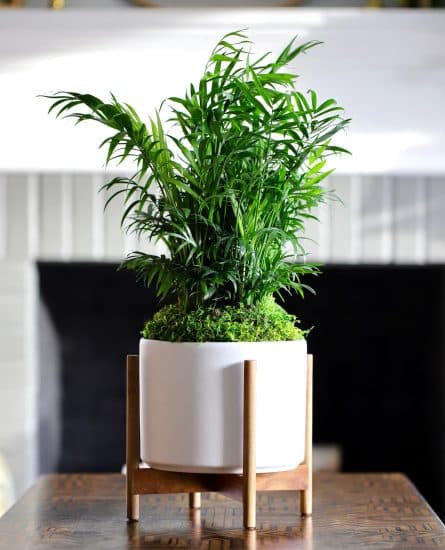
Part of the Arecaceae family (aka the palm family), the Parlor Palm, or Chamaedorea elegans, is the ideal indoor plant. Native to Mexico and Central America (specifically Guatemala and Honduras), this small forest understory plant has been a favorite since the Victorian era.
Why?
Well, it became a fad to own one, almost ascending into outright ‘mania,’ as it’s described in the literature, and the Parlor Palm was thought to imbue its owners with a worldly aura.
It doesn’t hurt that it’s one of the most tolerant and easy to care for houseplants you can find, and that part has outlived the fad.
The Parlor Palm has accrued a lot of names since the German botanist Carl Friedrich Philipp von Martius first described it in 1830. In fact, I’d call it somewhat of a nickname bonanza. Ready?
It’s also known as the Bamboo Palm, Dwarf Palm, Dwarf Mountain Palm, Good Luck Palm, Reed Palm, Parlour Palm, Neanthe Palm, Neanthe Bella Palm, Neanthebella, and Collinia elegans. And one more, my personal favorite — Miniature Fish Tail Dwarf Palm. Whew!
And elegant, they are. The Parlor Palm’s arching, slender green stems have 12 or more pairs of pinnate (one on each side of the stem) leaflets per leaf. Despite being a solitary species, the Parlor Palm is usually planted in clusters in a single pot to get a fuller, more shrub-like appearance.
This plant is a slow grower that takes years to reach its full height, anywhere from two to six feet tall and two to three feet wide when inside. Outside, though, it can reach up to 16 feet tall.
The xate (cut frond) of C. elegans is in high demand for its ability to stay green and vibrant for up to 40 days post-harvest. Florists use them for arrangements and wreaths, and they’re also popular in some religious ceremonies.
Parlor Palm Flowers
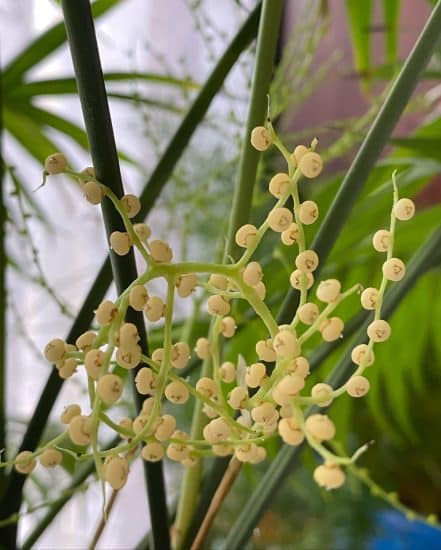
Mature plants regularly bloom indoors. If your Parlor Palm gets enough light, you’ll see spirals of yellow flower clusters.
Did you know: The inflorescences, or blooms, of a Parlor Palm are edible, although they taste a tad bitter. People in Guatemala and El Salvador regard them as a delicacy and eat them in salad or fried in egg batter, a dish called rellenos de pacaya. It’s sometimes served with tomato sauce. Yum!
Varieties
Chamaedorea elegans ‘Variegata’ has showy white markings.
The Chamaedorea genus also has other equally delightful varieties that may look like C. elegans, but are actually different.
- Chamaedorea erumpens has similar fronds to C. elegans, but with wider leaflets and a slightly thicker trunk.
- Chamaedorea hooperiana is a more recent variety with thinner, more upright leaflets, but the same type of dramatic branching growth as C. erumpens.
The Parlor Palm tree can grow in lower light conditions and withstand more temperature levels than many other plants (and purify the air to boot!). Let’s see just how hardy this species is and how to keep it thriving!
Light
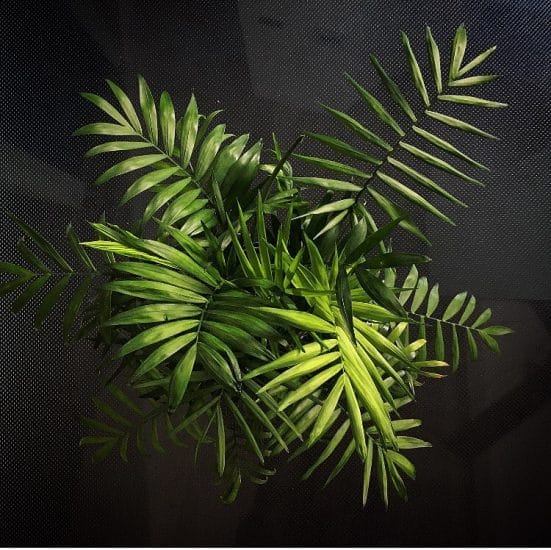
Even though the Parlor Palm is a low-light houseplant, that doesn’t mean it can get by with no light. In order to help your plant flourish, it’s important to find a place where it can get bright indirect light. Avoid direct light, since this can scorch and damage its leaves.
A north or east-facing window is your best bet, since they get the least direct sunlight. If the window faces west, it’s best to keep the Chamaedorea elegans at least a few feet away. With south-facing windows (all direct light!), keep your plant three to five feet away or filter the light with a sheer curtain.
Lighting tips:
- If your plant isn’t getting enough light, consider using artificial lighting (LED grow lights are energy efficient and often full spectrum). Parlor palms like at least 1,000 lux but will do better with 2,500 or more lux. You can measure this with a lux meter or an app on your phone.
- Monitor the leaf color to check if your plant is getting too much light (dark, leggy foliage) or not enough light (pale foliage, stunted growth).
- Turn your plant every week or so to make sure its leaves get an even amount of light.
Water
Watering a Parlor Palm is all about balance. The goal is to give this plant nice big drinks of water and then let the soil dry out just a bit so that it doesn’t stay perpetually wet.
A good rule of thumb is to forget about watering on a schedule. Instead, use your finger to check the top two inches of soil. If it’s moist, hold off on watering for now.
If the soil is getting close to dry, you’ll want to give this plant plenty of water, as it doesn’t like to completely dry out like some other indoor plants do.
Every plant’s needs will be different, but following this method, you should water your Parlor Palm plant about once every two weeks during the growing season. Dial it back to watering around once a month in the winter.
Always allow time for excess water to drain from the pot, and dump any water from the pot tray underneath.
Your plant not only needs the right amount of water, but it needs the right type, too. Tap water is fine, but if you can, opt for filtered, distilled, or rainwater. This avoids harmful chemicals in tap water that could build up in the soil.
If your plant isn’t getting enough water, its leaves will curve and their color will fade. On the other hand, overwatered plant leaves will turn yellow and wilt. Too much water can cause root rot, so if you’re not sure, better to err on the side of underwatering than over!
Temperature and humidity
Parlor Palm grow in warm, humid climates and USDA Hardiness Zones 10-12, so they do well in normal household temperatures of 65-80°F (18-27°C).
While Chamaedorea elegans is a tougher plant, prolonged exposure to temperatures below 50°F (10°C) can cause wilting, so keep it away from windows, vents, and outside doors that might let in cold drafts. And if you notice the leaves wilting or drooping in a warm environment, the temperature might be too high.
Humidity is just as important as temperature! You want to strike a balance to ensure your plant doesn’t become dehydrated, but also won’t be exposed to too much moisture. Humidity levels of anywhere between 40% to 70% should do the trick.
Brown leaf tips or edges could mean your plant’s environment needs more humidity. If your home isn’t humid enough (mine definitely isn’t in the winter), you have options.
To keep humidity at an ideal level, I keep plants near a humidifier and sometimes put them on a pebble tray (pebbles and water). You can also place it near other plants so they can share moisture (this is called transpiration).
The bathroom can also work wonders for a struggling Parlor Palm. Room temperatures and humidity are usually the highest here, just make sure there’s adequate light.
Note that misting leaves with water won’t do much to raise humidity long-term, but it will remove dust and potential pests. Just be sure to wipe them off after you’re done!
Soil and planting
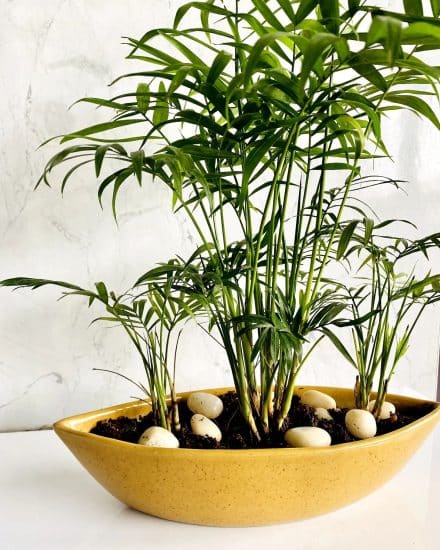
Parlor Palms grow well in a slightly acidic to neutral (5 to 7.5 pH), well-draining soil mix. A peat-based potting media works well, since this combo holds moisture but also allows the soil to drain effectively.
You can adjust your soil texture with other ingredients to promote moisture and drainage, like sphagnum moss, perlite, or coco coir. Consider tossing in a handful of horticultural charcoal to add necessary micronutrients like potassium, calcium, magnesium, and phosphorus (but don’t go overboard!).
As long as your potting mix retains enough moisture to keep your palm healthy while still draining well, it’s a winner.
Pruning
The Parlor Palm plant doesn’t really need pruning, but if you need to remove a dead or dying stem, take off a full frond, not pieces.
Repotting
Every two or three years, when your Parlor Palm is spilling out of its current pot or is root-bound, it’s time to repot. These plants have weak root systems, so be gentle when transferring them. Pick a pot with at least one drainage hole so your plant’s roots aren’t stuck sitting in water and prone to rot.
Fertilizing
Use a balanced liquid houseplant fertilizer diluted to 50% once a month during the spring and summer months. Don’t fertilize at all during winter, since this can scorch the plant.
You’re familiar with the ideal environment for your plant, but how do you make more of them? We’ll tackle Parlor Palm propagation next.
Propagation guide
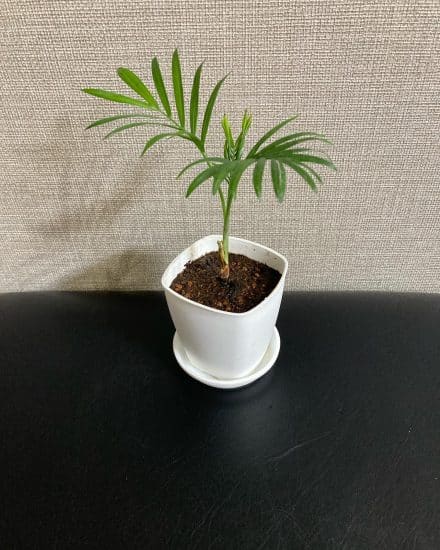
While it’s technically possible to propagate your palm plant through seeds or division, there are caveats.
Propagating Parlor Palm by seeds: This method involves picking healthy seeds and sowing them. It takes a long time (up to several months), requires a very specific set of conditions, and is usually left to professional growers. Additionally, Parlor Palm seeds are known for being unreliable germinators, so you’ll have to sow a lot of them.
Propagating Parlor Palm by division: While you can separate small bunches into smaller ones, I don’t recommend this method because Parlor Palms grow separately by nature — they’re only planted in multiples for aesthetic reasons. This means that any division attempt can stress out the plant and its roots.
Most people usually choose to buy additional plants as they’re pretty affordable and universally available.
Let’s go over the common issues that can affect Parlor Palm and how to deal with them (it’s pretty easy).
Common issues
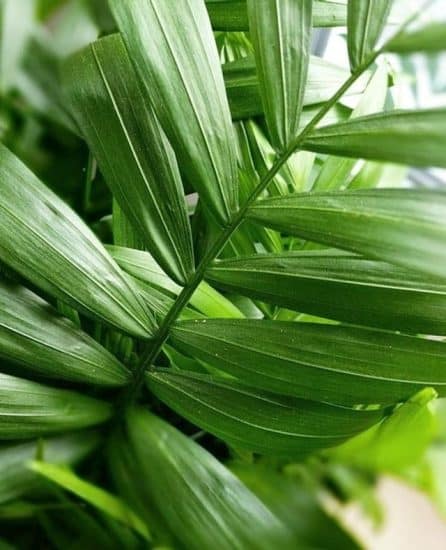
Most of the issues we see with Parlor Palm plants are due to light or water issues — too much or too little of either.
Brown Leaves
Chamaedorea elegans can get burnt leaves (yellow or brown patches) when they’re placed in too much direct sunlight, or when they’re not getting enough water. The location where the browning starts is the key here.
If the problem starts with brown tips and moves downward, it means your plant isn’t getting enough water or sunlight. Be sure you’re consistently giving your plant a nice drink of water and finding it a spot where it can bask in indirect sunlight.
On the other hand, if browning starts at the bottom of the frond and moves up, this might mean overwatering or root rot. Repot your plant in fresh, dry soil and wait a few days to water again.
Yellow Leaves
Ah, the dreaded yellow leaves! This can be caused by too much sun, overwatering, or fertilizer. Check to make sure your Parlor Palm is away from direct sunlight (or that it’s filtered), and if this doesn’t fix the issue, stop fertilizing if necessary.
Be vigilant for drooping, yellow leaves paired with mushy stems, which likely means overwatering. To fix this issue, always let the soil dry out between waterings, and make sure your plant’s pot has adequate drainage holes.
Diseases and pests
Parlor Palms are tough plants, but they might occasionally suffer an unwanted fungus or bug invasion. We’ll use these tried and true methods to solve the problem ASAP.
Root Rot
Root rot is a common issue that can occur when the Parlor Palm is overwatered or has poor drainage. To prevent this, make sure your plant is in well drained soil and its pot has adequate drainage holes. If the mix is holding too much water, repot your palm with fresh, more aerated soil (throw in some organic matter like coco coir or perlite).
If you spot any signs of root rot — black, slimy roots, wilting leaves, and brown spots — carefully cut off any slimy or mushy roots, repot your plant, and let the soil dry out before watering in the future.
Fungus
Look for small white, circular patches that appear on the stems, leaves, and often in the soil if damp. First, isolate the plant from others, remove all affected leaves and stems, and spray it with a fungicide. Consider misting and wiping your plant off with a cloth regularly afterward in order to help keep the fungus away.
Pests
Chamaedorea elegans can have the usual pests, such as mealybugs, aphids, scale, whitefly, or spider mites. Keep an eye out for small white bugs or webbing on the underside of leaves and around the stems. If you see any, immediately isolate the plant and use a damp cloth to wipe off affected areas. For more severe infestations, use an insecticide (follow the directions on its label).
Make sure you get both sides of the frond.
Conclusion
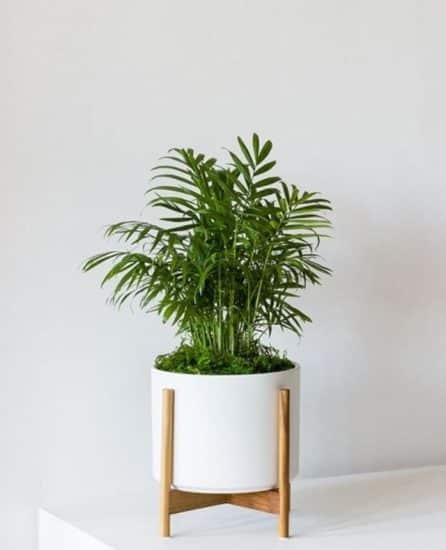
We know Chamaedorea elegans is elegant — it’s in the name, after all! Elegant and easy to care for. You definitely don’t need a green thumb with this one, since it’s low light tolerant and prefers normal household temps.
What are you waiting for? Go out there and get one of your very own Parlor Palms!
(Or admire the one you already have).
If you found this article helpful, why not send it to a plant-loving friend? And just FYI: We’re around on Facebook and Twitter to answer any questions (or ooh and aah over any plant pics!).
FAQ
Are Parlor Palms good indoor plants?
Yes! Parlor Palms are excellent indoor plants because they’re tolerant of low light and a range of household temperature levels.
How much sun does a Parlor Palm need?
While these plants can survive in low light, they prefer bright indirect light, at least 4 to 6 hours a day.
Can a Parlor Palm live in the bathroom?
Provided said bathroom has enough light, definitely! The humidity in a bathroom is ideal for this plant.
How often should you water a Parlour Palm?
Water a Parlor Palm when the top two inches of soil is dry. If you’re not sure, it’s better to underwater than overwater to prevent rotting roots.
Are Chamaedorea elegans easy to care for?
So, so easy! These plants are some of the easiest to maintain that I’ve ever come across. Just make sure they’re not in too much direct light or soggy soil, and they’ll be happy as clams — and so will you!

